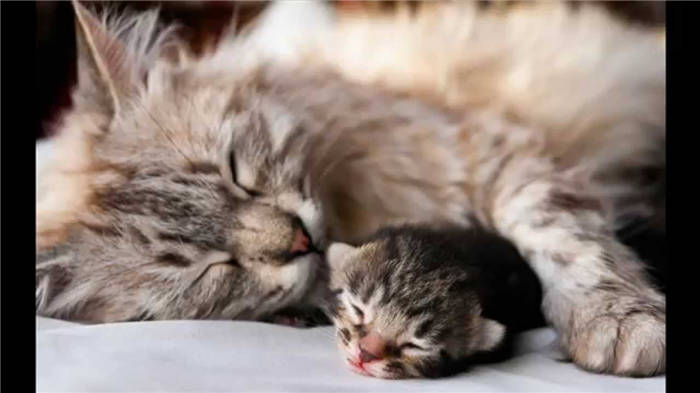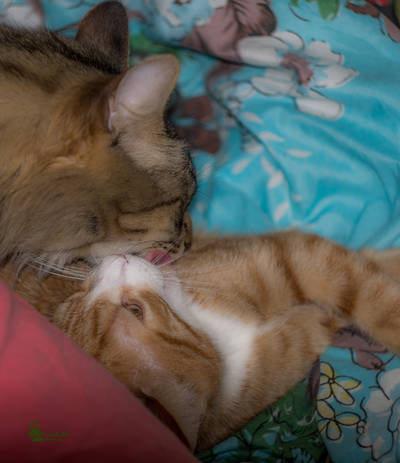On average, it takes two weeks for the cats to get acquainted. Kittens accept each other almost immediately, adults can "get used to each other" for a couple of months. Separate areas must be created for the pets, with the possibility of contact. It happens that cats do not accept each other.

- 8 questions to the zoopsychologist about cat friendship
- Dating Scenarios
- Adult – cub
- Choosing a mate
- Lack of competition
- Toilet
- Food
- Sanctuary
- Games
- Aggression
- Fear
- 8 Tips for Resolving Conflicts Between Cats
- How to reconcile two pets: the first steps
- Ways to make the pets feel at ease
- To avoid conflicts, you should introduce the cat to the baby in several stages.
- Are cats asocial creatures?
- How to avoid conflicts in the "cat house"?
- Is it worth getting a cat if you already have one at home?
- Causes of conflicts between two cats and how to avoid them
- Community Rules
- Response Matyr in "Decided to share a "tip"
8 questions to the zoopsychologist about cat friendship
Making friends with a new cat is not the easiest task! You're lucky if your cat is ready to take in all the animals from the neighbor's cat, to the crocodile, but not everyone is so lucky! Most people have to make a lot of effort to explain to their cat that he is not the only and unique kitty in the universe, and now he will have to share the owners affection with the other pets.
Many articles have already been written on how to introduce cats to other animals. Every week I do several consultations on introducing cats or introducing cats to dogs. At this point I have formed a list of questions that I am most often asked by cat owners who have decided to get a new pet, or those who have already encountered difficulties in adapting their pets to each other. In this article I will try to answer the most popular questions.
1. If the cats don't get along right away, is that it? Nothing will work out?
Cats are territorial animals, so most of them have a hard time accepting a new pet at home, especially another cat. Their territorial instinct tells them that they must be the sole owner of the territory, especially a small apartment or a private home. Cats, though predators, are prey to larger species. If a predator invades their territory, their "hit or run" instinct kicks in. That's why cats, at first, may show aggression or fear when they see a new pet – they see them as competitors for territory and resources or as enemies who might hurt them. But that doesn't mean it will stay that way forever.
Of course, the first reaction means a lot for the further relationship between the animals, which is why I do not recommend introducing the cat to the new pet from the doorstep. It is better to do it gradually, according to the scheme "one feeling – one step". This way the cat will make sure that the new tenant is safe and will not be threatened and it will get used to him little by little.
Dating Scenarios
The solution to the problem of how to make friends with cats in an apartment takes different time. The time depends greatly on the age and character of the pets.
Toddlers, even once in the house apart, quickly find a common language. The kitten is not inclined to defend the territory, ready to make contact. Loyalty helps the cubs to survive when left without their mother. Another nursing cat may accept a foundling, but will suppress attacks on her own offspring.
The coexistence of kittens is due to natural curiosity, lack of experience and the level of development of the hormonal system. Until puberty begins, the animal is actively getting to know new residents.
Adult – cub
The question of how to make friends with an adult cat and a kitten is more difficult to solve. It is believed that females are more loyal to babies. But the reaction depends on the character. The cub and the adult "invader" will be equal for the first few days for the unborn female.
Habituation usually comes more quickly, as there is no aggression from the opponent.
You should not interfere with natural communication if the animal hisses, runs away. Aggression will stop the kitten from close contact, and the adult pet will gradually get used to the alien.
Separation is necessary when there is a clear display of aggression. The problem arises when a person thinks about how to befriend a cat and a kitten. Males are less loyal to cubs.
Kittens are often called juveniles. Approaching the size of their adult congeners, they, while remaining active, show signs of mature behavior. The acquaintance of such a pair will be complicated. The cat will see a full-fledged rival, the juvenile a mixture of territory invader and play partner.
Acquaintance can be simplified if the adult animal comes into the house with a cub. The kitten will not defend territory, warily eyeing the newcomer, giving him time to acclimate.
Choosing a mate

If the new cat is not an emergency, but is planned in advance, you should think about the sex, breed and age of the newcomer.
- Two kittens get along perfectly, even if they are not from the same litter. Young animals that have not reached puberty need the company of congeners to play, often sleeping in a cuddle.
- It is not so desirable to place a kitten with an adult cat. An older cat will not be happy with the molestation of a hyperactive baby. And the kitten will quickly grow up and, having reached puberty, will try to take the leading role, which will lead to a new wave of conflicts.
- It is believed that two cats are the most difficult to get along with each other.
- Females can live together without open confrontation, but there is no guarantee that affection will develop between them.
- A bifurcated pair is the best option, but in this case it is necessary to spay the pets in time to avoid unwanted mating.
It is good when the animals have a similar temperament. Sometimes it is impossible to predict in advance, but if the cats are pedigree – the character is approximately known. For example: a phlegmatic Briton will hardly match a frisky oriental.
Lack of competition
Lack of resources is the main reason for pets to dislike each other. This applies not only to food, but also to a place to rest, attention of the owner. For cats to make friends with each other, they should not perceive a congener as a competitor. The task of the owner is to create abundance in the apartment.
Toilet

The number of toilet trays is equal to the number of cats living in the house – at least at first. Sometimes there are recommendations to put one more litter box. Even if the pets will visit each other or use only one litter box, you should not be in a hurry to remove the extra litter box. If the animals have to go to the toilet at the same time, and it is not possible – the situation will end up in a puddle on the carpet or a fight, or both troubles at the same time.
Food
Feeding can be a problem: unlike dogs, cats rarely eat their fill all at once, preferring to nibble on a few pellets throughout the day. Preventing theft from other people's bowls is almost impossible.
Sanctuary
All cats should have their own hiding place. There they will hide from a common enemy (a child, a dog), and there they will run away after losing a fight with a congenie.
It is not necessary to buy special complexes with houses, as long as you do not forbid the pets to climb into cabinets and on the mezzanine. At first, the opportunity to hide is so important for the newcomer that you should put a few cardboard boxes with a cut-out entrance in the room or even equip paper tunnels.
Games
The number of claw boxes should be increased in proportion to the number of cats, as in the case of toilet trays. In addition, it is recommended to give time to each pet, encouraging active games with a fishing rod, ball, bow. This will let off steam and energy in a safe way.
Aggression
Unfortunately, sometimes animals show real aggression toward each other. Cats may start jumping on each other, pawing or chasing each other around the room. If this happens, you should not interfere, but simply watch and let the animals find out if the two cats can get along in the same apartment and "who's the boss". However, if the aggression turns into a fight, it is worth dispersing the animals (do not separate them with your hands!) and temporarily separate them in separate rooms.

And then, after a pause of a couple of days, try to get acquainted again. One should do it till cats or kittens will get used to each other and will not be more quiet at the sight of a congenial.
By the way, the most efficient way to separate fighting cats is to pour water on them. If it did not help, you can put a thick blanket over them, the darkness should scare the animals. If this does not work too, try to pull them apart using any long stick, a mop for example. Be persistent, but careful not to hurt the animals.
The most common breeds of cats at home are: Sphynx, Scottish Fold, Munchkin, Burmese, Persian, Siamese, British, Burmese, Ragdoll, American Curl, American and Masquerade.
Often the cause of aggressive behavior is the sexual instincts of cats or cats. In this case, if there is no way to reconcile them, sterilization is the only option.
Fear
If cats do not react and do not contact each other, then there is a possibility that it is a manifestation of fear. They may be tense in each other's presence, hiss, run away, crawl under furniture, lose their appetite and even show aggression.

This can happen for several reasons. First, if the domestic cat or cat has never before interacted with their congeners. Secondly, perhaps you were too hasty with the first acquaintance, tried to bring the animals together forcibly, and this caused fear in them.
In any case, remember that your pet also has its own character and tendencies, and if it is fearful in normal life, it is unlikely to be happy with the appearance of a second four-legged family member. But that does not mean that these animals cannot be befriended. Just that it may take longer.
Important! You must be prepared for the fact that the two cats will never be able to reconcile with each other. And being in constant stress, they can start to get seriously ill. Then there is only one solution: find a good family for the newcomer.
8 Tips for Resolving Conflicts Between Cats
A cat in the house is a delight to the eyes, tenderness to the hands and medicine to the soul. Watching a cat is a pleasure, and when there are several cats, watching them interact is endless. When cats live in groups, they benefit from living together, because living in a group offers many advantages. Cats learn all kinds of tricks from each other (mostly hooliganism), play together, sleep in cuddles, lick the ears of their furry "brothers" and "sisters," and often seem to love each other very much. But in any group, whether a human family or a feline community, disagreements can arise. Introducing a new cat to the group requires patience and some knowledge. Some cats take a long time to accept each other, and other cats can never seem to coexist peacefully. So how can you help cats accept each other with minimal disruption and prevent quarrels in an existing community? Read on to find out.

Depending on how many cats live in your home, they may form one or more social groups. Take the time to really research the subject and find out who interacts with whom most of the time, if there are cats that tend to live in the same area of your house, if there are those that avoid each other. Answer the questions: Do conflicts happen every time with the same cats? Do conflicts occur in the same places? What are the locations and who lives there? Perhaps one cat is not happy because another cat who is not in her group is constantly trying to gain access to the litter box or get to food by crossing her territory.
2. Create easy access to resources.
Two of the most common mistakes I see on calls are that owners create a single feeding area for all the cats in the house and set up litter boxes next to each other in the same room. Given the layout of Russian apartments, it often turns out to be two trays in the toilet and bathroom, and bowls in the kitchen, where a narrow corridor leads from the rooms. It turns out that all the cats daily encounter with their noses next to the litter boxes and bowls, not being able to separate in space and meet their "enemies" less often.
How to reconcile two pets: the first steps

For a cat, the arrival of a second pet in the house is stressful, and it is only realistic to make friends with them when the animals have enough time to get to know each other. And to help the pet quicker adapt to this situation and get used to the idea that the little kitten is now a full member of the family, the owner must provide the most comfortable conditions for cohabitation of both pets.
- You should not force the events and confront the pet with the new inhabitant as soon as it appears in the house. First you should check how your cat will react to the kitten, and if she does not show any aggression, you can let them get to know each other better;
- You should not leave the animals unsupervised in a room together hoping that you will bond them and make them friends since the behavior of an adult pet is difficult to predict. He may take advantage of the owner's absence to attack the kitten and cause serious harm;
- You will not be able to make pets friends if the baby steals food from the cat's plate. Therefore in the first days it is better to feed the kitten separately and not allow him to go to the bowl of the adult pet;
- Cats are very jealous of their litter box and may refuse to go to it if the kitten leaves traces of his presence there. Therefore, a small pet should have its own litter box to correct its natural needs;
- So that the baby does not take up the cat's favorite house or its bedding, it should be given a separate place to rest;
- You can make the cat and the new kitten friends by playing together. Playing with the baby, include the adult cat in the game, this will bring them closer to each other and allow them to get to know each other better;
- You should not allow the baby to do things that are forbidden to the first pet, such as sleeping on the table or eating from the owner's plate, because this will cause more jealousy from the old-timer;
- If the cat begs for affection, do not deny it, because it wants to make sure that the owner still loves and values it.
Ways to make the pets feel at ease
Depending on the sex of the pet, the reaction of the cat and the cat to the new pet will be drastically different. The cat may take the arrival of the baby more calmly, as there is a high probability that her maternal instinct will kick in on the kitten. Of course, this is provided that the pet is not spayed. Often a fluffy pet begins to take care of the kitten as her own cub and teaches him all the necessary cat tricks.

Males do not bother to take care of their offspring and they have no maternal instinct, so it is somewhat more difficult to make friends with a cat and a kitten. A cat is very jealous and vigilant about its own territory and even a small pet will take it as a future rival and even begins to sweep the corners with its urine to show who's boss in the house.
To avoid conflicts, you should introduce the cat to the baby in several stages.
- In the first few days the kitten should be in a separate room, and not roam freely around the apartment. This way the adult cat will not suspect that the baby is claiming its domain;
- In order for the cat to get used to someone else's smell, it is advisable to let him into the room where the kitten lives. Naturally, the baby should be placed in another room for this time so that the pet can explore the territory in a quiet environment;
- The first acquaintance of the pets should take place under the supervision of the owner. If the male behaves in a hostile manner towards the kitten, the animals should be separated into different rooms and reintroduced only after several days;
- The kitten should not be allowed to eat food from the old-timer's bowl, especially in front of the adult pet. This will only convince the cat that he has a rival who is encroaching not only on his territory but also on his food;
- Castrated cats are more friendly and peaceful towards other animals. Therefore a tip for owners: it is advisable to spay an adult cat before getting another pet.
Are cats asocial creatures?
But we should not think that the whiskers – irreconcilable asocials.
Both stray and owner cats, under certain conditions, form stable groups. True, murkies do not hunt and defend themselves together as pack dogs do, but living and eating on the same territory, they treat each other either neutrally or very friendly.
In the latter case you can see how buddy-cats sleep in each other's arms, play together, affectionately lick each other, purr and rub their cheeks in a peaceful way. All of this can be to be considered human expressions of affection. and if there are quarrels in such a community, they never turn into serious fights. In the end, the cats' affection to their owners is also an element of social instinct that confirms their ability to get along with other people on the same territory.
Life experience and individual character of an animal are of great importance in this case. In particular, a kitten, spoiled by the permissiveness of the owners, can grow up to be a real mini-tiger, establishing the laws within the boundaries of his "kingdom.
Modern zoopsychologists confirm that it is necessary to socialize and educate not only dogs, as it was thought before, but also cats, so that living together with a pet was comfortable and problem-free. In addition, among the 200 cat breeds there are those that are characterized by innate soft temperament, peacefulness and amazing tolerance for the environment.
How to avoid conflicts in the "cat house"?
Considering the above, we note that the probability of peaceful coexistence of two cats will be much higher if you take into account the following recommendations.
1. As a pair for your pet choose, if possible, Good-behaved prospective mate – An aggressive and choleric character is very difficult to correct. And even after appearing on someone else's territory, such a cat will behave as an aggressor and begin to pursue and offend the "rightful owner".
2. It is practically impossible to make friends with two adult, not neutered cats – because male cat's claims involve not only the hunting grounds, but also the instinct of reproduction. And even if the striped moustaches disperse into different corners of the house, they can't avoid the "heated" meetings. Pugnacity is a natural feature of males, and the role of such confrontations in nature – to identify candidates for the stronger and more worthy of leaving offspring.
Moreover, unspayed cats living in one area invariably leave their urine tags, competing in this "fragrant" way. Passions flare up when the males smell a cat in heat nearby. Thus, the only way out in this situation is to neuter both "roommates" so that one of them takes the dominant position and the other demonstrates his consent and obedience.
3. A more acceptable option would be a mongrel animal . But even here we can't do without neutering at least one of them, because male-dominant old-timer can start "educating" the female, hissing her hair, giving warning blows with his paw, driving her away from the bowl with food and not giving peace even in the recreation area. On the other hand, a neutered cat is more malleable, quiet and not concerned about "testosterone problems". He most likely will not harass the new cat if she won't try to get his food or show her character as a "squabbling wife". In turn, spayed cat – a guarantee of absence of appealing cries at night and unexpected litters, as it is difficult to notice the heat and to separate the animals in time.
Is it worth getting a cat if you already have one at home?
Before getting a second cat, you should know that the more cats in the house – the more time for cleaning and more expenses.
-
The pet is too active and sleeps during the day due to boredom and wakes up the owners at night;
Will the cats be able to become friends? A lot depends on the sex of the first pet. If the pet is spayed and the new friend is to be spayed as well, then the sex does not matter.
Two cats that are not neutered can start tagging the house with fury and fight with each other. Even if you move a neutered cat to your home he will succumb to his instinct and will molest him. Therefore, the best way to make friends with cats is to get females.
Girls don't fight over their territory and the smell from their tags is much weaker. It is easier for kittens to make friends than adult cats. It's ideal to get kittens from the same litter. You should also remember that the longer the pet lives alone, the more difficult it will be to get used to a new neighbor.
Causes of conflicts between two cats and how to avoid them
Cats get used to a particular way of life, and therefore react to the arrival of a new neighbor without joy.
If cats don't get along, there are two reasons for that – a dispute over territory, the older reserved cat is irritated by the wild character of the younger cat.
All felines are solitary hunters, the only exception being lions. The owner will quickly see the pet's objection to the new tenant. The cat will begin to tag clothes and shoes, urinate in inappropriate places, express hostility, and damage curtains and furniture. A well-bred cat can change its character beyond recognition.
-
The first cat should be vaccinated to avoid catching contagious diseases from its neighbor.
Community Rules
Insult others. Using foul language or swearing is forbidden. Replacing part of the letters with "@", "#", "$", etc. when the original word is computable does not get rid of responsibility. The use of coarse proverbial language and references to physiological abnormalities are categorically discouraged;
✔ Posts off-topic. ✔ Posts must be relevant to the stated topic of the community;
✔ Posts about helping animals in the community without the obligatory tags: #dobryeruki #help #unrated
We'd also like to remind you that there is a special community on Pikaboo called "Aybolit. Help for Animals"
Dear friends who do not like the posts asking for help for animals, please add the tags: #help #dobryeruki, etc. to the black list.
✔Plagiarism! Don't misappropriate other people's ideas, writings, or other author's content.
✔Correct comments in the comments, outright flooding, provocation, propaganda of cruel and irresponsible attitude to animals, etc. participants are blacklisted without additional explanations and warnings!
Don't forget to tag "my", "cat", "catmafia" if you post your pets.
I have 2 cats, the oldest is 5 years old, the smallest is about 7 months old, they eat from the same bowl, go to the same litter box. The older cat from the first day re-trained himself as a caring mother, licks, covers the unexpected small, flying at the first meow, patiently lets the little one to the food first

We have two cats from the same litter. Took them right away together, brothers were thick as thieves. Sometime in the age of a year and a half, they just meow from love to hate. They've been living in separate rooms for two years now. Otherwise, they fight to the death. None of your advice works in their case.
The cats are neutered.
My parents always have 5-6 cats at the same time (private house), and quite often there are newcomers (someone threw a kitten right under the door, found and brought home, etc.) Older people are basically used to and do not pay attention, if a new recruit appears, no conflicts ever. Kittens, of course, are afraid of them at first, but there is nothing to be afraid of, in principle, no one hurts anyone
Response Matyr in "Decided to share a "tip"
Shtosh! Since such a topic came up, I'll answer.
I apologize in advance for such a personal topic, but what if someone useful.
Many men face the problem of smell from the legs at the end of the day and the smell from the armpits. Scattered socks with this smell leads our favorite women in a stupor. And no simple hygienic procedures do not give a lasting and sustainable effect.
Let's start with the feet:
1) We go to the pharmacy and buy the ointment "teimurova paste", the drug penny and natural, there are from ancient times, maybe even the great Ukra already used in the Mesozoic times)))) .
2) At home before going to sleep on wet feet and put on socks (not to soil the sheets and not to scare others look white heels), to pay attention to the space between your toes.
3) In the morning rinse everything
For a week the smell from your feet will practically disappear if you change your socks regularly (every day). If the procedure is repeated every 3-4 days for 2 weeks, the effect will surprise you. The smell may not appear for six months or more.
Underarm odor:
1) Remove the hair with a razor, for brutal men I will say that it has nothing to do with gayness. Normal hygiene and respect for others and the woman he loves. (For some people it is not acceptable, you can not shave, the effect will be worse).
2) Repeat the whole cycle, as with legs.
Bottom line: No problem with the smell, you can easily undress in public and not embarrassed. And will not be necessary in transport not to hold on to the handrail to prevent others from fainting. There are other preparations, the one cited in this post is the cheapest and most affordable.
I expect a lot of minuses and comments: "everyone knows it", "banana", "what's the point of it for a real man?
And yet I hope it will be a little more pleasant to ride in transport in summer and maybe someone will not be ashamed to come in and take their shoes off.
P.S. Yes it's bayan-bayan post released by comrade @soha 8 years ago, but since the thing is useful, then let's remember. Who is not sorry can give him a plus sign here: How to get rid of sweat smell? Or Polichinelle's Secrets.






